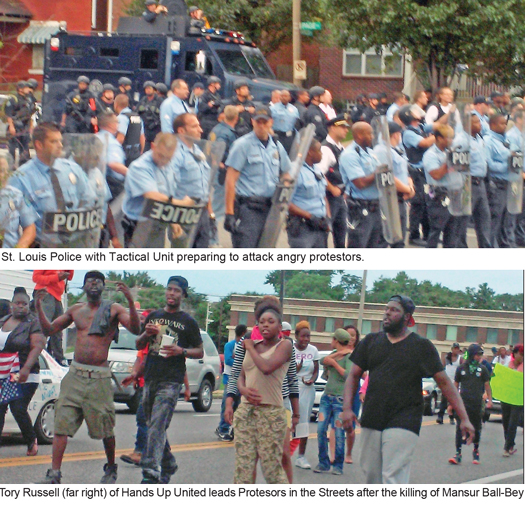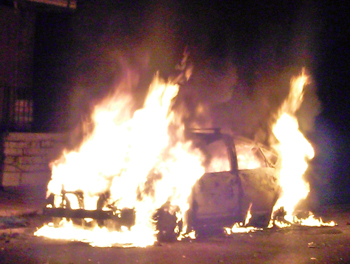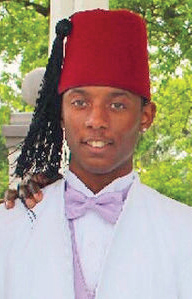
What's your opinion on this article?
|
|

Photos: J.A. Salaam
|
But was this a new phenomenon or were police brutality, killings and mistreatment of Blacks at the hands of White law enforcement steeped in the history of St. Louis and was a racial explosion inevitable? In a 1943 book written by Gustavus Myers, “History of Bigotry in the United States,” the author referred to St. Louis as a city that had never had a riot or uprising at that time except the Riots of East St. Louis in 1917. Those riots targeted Black people.

Car set on fire the night of Mansur Ball-Bey’s killing Photos: J.A. Salaam
|
Several hundred protestors arrived at the scene where 18-year-old Mansur Ball-Bey of the Moorish Science Temple was fatally shot Aug. 19 by a White police officer in mid-town St. Louis. The shooting happened after the teen fled from two plainclothes officers issuing a search warrant at a family’s residence, said the authorities. St. Louis police reported that the teen and another youth ran out the back door and the victim pointed a gun at the officers but didn’t fire a shot. Family members of the teen insisted he didn’t have a gun. He had just got off his new job at FedEx and was still wearing his uniform, they said.
St. Louis Police Chief Sam Dotson reported in a press conference that the teen pointed a gun at the officers and a weapon was found at the scene. An autopsy found young Ball-Bey died from a single wound in the back, police officials said.

Mansur Ball-Bey
|
Protestors marched through the streets blocking traffic and chanting, “F--k the police!” Chief Dotson and over 30 police SUV’s and the Military Tactic Unit arrived to disburse the crowd.
When officers arrived and stood off with protestors, bricks and other objects fell at a line of officers. Some felt the police in riot gear were overly aggressive. Tear gas and non-lethal projectiles flew through the air.
“People are angry and mostly want answers. I think that if there was more transparency people wouldn’t be out here trying to figure out what the police is trying to hide. But more than that, I’m frustrated by the fact that there are White people who aren’t from this neighborhood that’s coming in burning things down then get to leave and go back to their White neighborhoods. That’s not cool,” said Destiny Crockett, a 20-year-old St. Louis resident.
“You don’t get to come and burn up the ’hood and cause destruction and make it look like it’s us doing this. It’s a lot of White people. We saw definitely more White people doing it who aren’t from here like Black people. It’s different. If it was Black people because they have pain here, they have frustration and rage here,” she added.
Black people in St. Louis have always been strategically moved around the region and kept in a powerless position for years. The mass relocation of Blacks to small municipalities in north St. Louis County, such as Ferguson-Florissant, Delwood, Normandy, Wellston, Kinloch and others produced major White flight and increased racial hatred and anger toward Blacks.
Today the relationships between Blacks and Whites in St. Louis has not gotten better but rather has deteriorated. Since the Brown killing, law enforcement is clearly seen as enemy of the Black community and not the protectors and servants they swore to be.
“The problem we are having won’t stop until we change the system where those that have and the have nots get on an even playing field, or it won’t be right. It’s the powers that be that has the police killing those without the means to defend themselves,” said Larry Miller of Ferguson Freedom Fighters.
“The people are angry and feel as if they aren’t heard and this is a way to be heard. For everyone who says, ‘oh they are tearing up and burning their community or destroying their community.’ It’s difficult to tell people who are hurt, who are angry, how to act in different situations and there needs to be change. So for people to say they are animals for rioting, people have rioted for less—for baseball games and things of that nature. I feel people are angry and it’s not right to look down on them for being angry,” said Kielah Harbert, a 19-year-old student at Washington University in St. Louis.
St. Louis is where the Dred Scott decision by the U.S. Supreme Court in 1857 was the culmination of more than a decade of litigation over freedom for slaves Dred and Harriet Scott. The legal battle began in St. Louis where the Scotts won an initial victory. However, the verdict was appealed to the Missouri Supreme Court, where the ruling went against the Scotts. Some legal maneuvering brought the case to America’s highest court, where the institution of slavery was upheld by denying Dred Scott the rights of citizenship. The ruling laid some of the groundwork for the Civil War and put St. Louis in the forefront of discussions about race and rights.
“I feel that there should be an explanation why. How much tension is coming off from Black kids being killed, and with no explanation, people just start getting riled up. That’s why stuff like this happens. I understand a peaceful protest is good but at the same time, standing, looking in (police) faces, isn’t doing anything. They don’t care about that. They still get paid standing out here. So why not cause some hell, make some noise while we are standing out here, and make them understand how we feel?” asked Malik Johnson, 19.